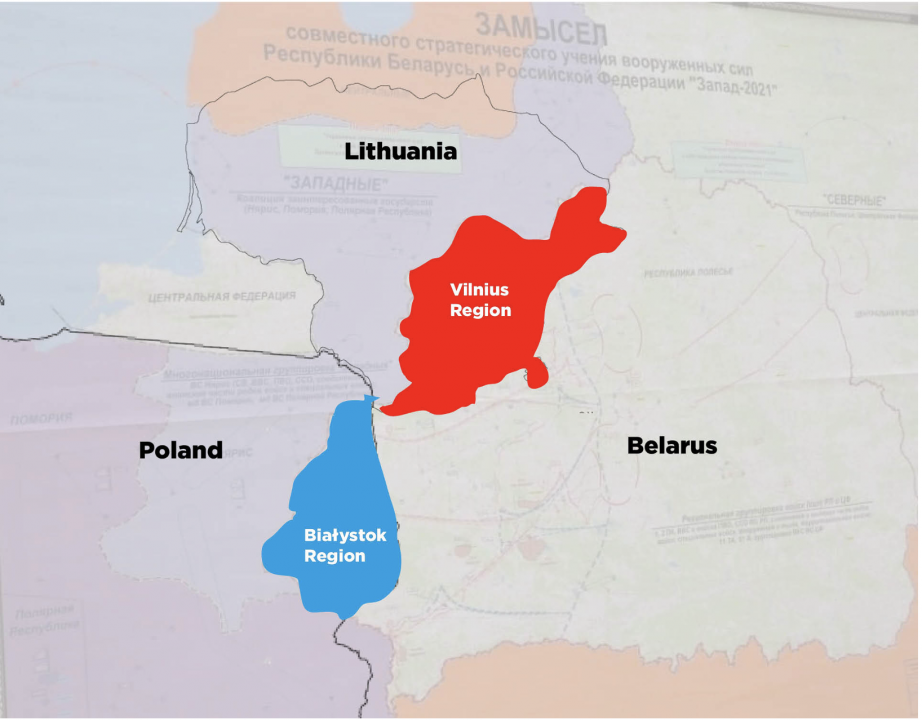Belarusian territorial ambitions reflected in military exercise’s imaginary maps
ZAPAD21 exercises send tough message to Poland and Lithuania, employing made-up country maps and bombastic statements

Banner: Belarusian President Alyaksandr Lukashenka meets state security officials in Minsk on September 27, 2021, 10 days after the end of ZAPAD21. (Source: Maxim Guchek/BelTA/Handout via Reuters)
In a speech marking the end of the quadrennial ZAPAD21 joint military exercises with Russia, Belarusian President Alyaksandr Lukashenka referred to Vilnius, Lithuania and Białystok, Poland as Belarusian territory. These claims correspond to war game maps published by Belarusian media during the exercise.
On September 17, 2021, at the end of the military exercises, Lukashenka spoke at an event marking the first-ever National Unity Day, marking the anniversary of the Soviet Union’s 1939 invasion of Poland at the outset of World War II that merged western Belarus into the eastern Belorussian Soviet Socialist Republic.
The maps that emerged during the exercise feature an imaginary country called “The Republic of Polesie,” which overlaps modern Belarus yet also incorporates Vilnius and Białystok. The use of such maps during ZAPAD21, alongside Lukashenka’s provocative remarks, could be considered a warning sign to Lithuania and Poland, both of which have been staunch supporters of pro-democracy protests in Belarus for more than a year.
Lukashenka’s Speech
National Unity Day was commemorated for the first time on September 17, 2021. According to Lukashenka’s office, the day symbolizes “restoration of historical justice and reunification of the Belarusian nation that was forcibly divided in 1921 in line with the Treaty of Riga.” From the period of 1921 leading up to the 1939 Soviet invasion, this region was considered part of Poland’s national territory. It was then annexed to the Belarusian SSR, forming a “unified” Belarus.

To mark the event, a Patriotic Forum “Symbol of Unity” was held in Minsk Arena. It was in this context that President Lukashenka gave his speech and commented on the political situation in the region.
During his speech, Lukashenka said that the Belarusian authorities have never laid claim to foreign territories, and Minsk “is trying to establish peace and friendship in relations with all countries” as the “neighbors are given by God, like any other country.” He then proceeded to claim that the Lithuanian capital Vilnius and the Polish city of Białystok are Belarusian lands, yet added that Belarus was not making territorial claims to these cities. “Today we do not even remind them [Poland and Lithuania] that Białystok and Bialystochina are Belarusian lands, that Vilnius is also a Belarusian city, and the lands around it,” he proclaimed in Russian. “We are not talking about this.”
His remarks were followed by loud ovations.
This story was quickly picked up by pro-Kremlin media outlets and social media accounts. According to data collected from social media listening tools Crowdtangle and Buzzsumo, there were 51 stories and 114 Facebook posts published in Russian containing the keywords “Лукашенко Вильнюс Белосток” (“Lukashenka Vilnius Białystok”). These posts, however, received relatively limited engagement.

The ZAPAD21 exercise maps
Lukashenka’s statement was also reflected in the cartography of ZAPAD21’s war game maps. On September 9, photos of these maps appeared in Belarusian media when they were published by SmartPress. The article featuring the map photos did not present any official explanations regarding territorial changes presented on the maps. By September 12, the same photos of the maps started surfacing on Twitter and Telegram.
In the ZAPAD21 training scenario, according to SmartPress, “The Republic of Polesie” (Республика Полесье) represented Belarus, which had formed a “western alliance” with the “Central Federation” (Центральная Федерация), representing the Russian Federation, including the Russian exclave of Kaliningrad sandwiched between Poland and Lithuania. This alliance would face off with a “Northern Alliance” comprised of the imaginary countries of “Nyaris” (Нярис), “Pomoria” (Помория), and “The Polar Republic” (Полярная Республика), representing areas of Lithuania, Latvia and Poland, working in conjunction with so-called “international terrorist organizations.”
According to the exercise maps, the Republic of Polesie fits within the borders of Belarus, but with the addition of Vilnius and Białystok.


President Lukashenka is well known for his belligerent statements and threatening Belarus’s neighbors. His remarks and the use of these imaginary maps are yet another example of Lukashenka’s subtle threats to its Belarusian neighbors, which remain staunch supporters of democratic processes in Belarus that would replace him as president. Not unlike the ongoing migration crisis engineered by Belarus, these signals can be interpreted as a willingness to raise the stakes in Lukashenka’s ongoing confrontation with Poland and Lithuania, as well as the potential instigation of nationalistic feelings within Belarus, potentially fragmenting Belarusian supporters of democracy.
Cite this case study:
Lukas Andriukaitis, “Belarusian territorial ambitions reflected in military exercise’s imaginary maps,” Digital Forensic Research Lab (DFRLab), September 30, 2021, https://medium.com/dfrlab/belarusian-territorial-ambitions-reflected-in-military-exercises-imaginary-maps-78a7358ce38b.

